The impact of PD in a 1:1 teaching environment
 A trio of middle grades educators from Mill River Union High School, in Clarendon, Vermont, presented the results of their semester-long action research project, examining what role professional development plays in increasing the amount of time technology is integrated into the classroom in a 1:1 environment.
A trio of middle grades educators from Mill River Union High School, in Clarendon, Vermont, presented the results of their semester-long action research project, examining what role professional development plays in increasing the amount of time technology is integrated into the classroom in a 1:1 environment.
Mary Colvin, Jen Little and Brendan Nerney all teach 7th and 8th graders at Mill River Union High School, and as part of attending 2015’s Middle Grades Institute, undertook an action research project to measure just what kind of an impact PD has on teaching practices in a 1:1 environment. They sought to answer the question, “How does professional development affect technology integration?” The school is in its third year of a 1:1 initiative with iPads.
This is what they found

Transcript below.
Where we started from, and how we structured professional development for our 1:1
Mary Colvin: Our research question was, “How does professional development affect the implementation of classroom technology?” Three years ago we rolled out our 1:1 program for 7th, 8th and 9th graders in our building, and this visual shows a pretty good idea of where we’ve been and where we are now:
We started with a rock and an arrowhead, maybe we got to the quill pen and now we finally have devices that we’re using, as far as our knowledge base goes. We really were handed devices a few weeks before students and told, “Figure them about before the kids do.”
That was a thing we realized was a huge issue affecting technology implementation in the classroom. So thank you to the Tarrant Institute and our relationship with them that we established this summer, we were able to get that opportunity going.
The evolution of our PD
Year 2013-2014 we rolled out the 1:1 program with very little professional development. What we had was our librarian/technology specialist telling us, “Here’s some great things you can do! Or, next Tuesday at 3 o’clock, if you want to come, I’ll be talking about this thing!” It was very voluntary and not really structured. And when given options, we’re as bad as the students and don’t really go to things. There was not much professional development.
In the second year of our 1:1, 2014-2015, we had that same librarian saying, “Hey, here’s some great stuff!” which was fabulous, but we just didn’t have the time for collaboration.
This current year, 2015-2016, we went to MGI over the summer and worked together as a team to create a digital citizenship curriculum to implement for grades 7-9. Grades 7 and 8 having the same program and grade 9 having a little bit different but still structured program.
We also implemented PD days, and thanks to Rachel Mark for getting really organized and beneficial PD for us, instead of us just having an inservice day and looking around for something to do. We really did work with “What do we need? Where are people with their learning?”
It was a nice tiered approach: here are the people who don’t know how to turn their computers on, here are the people who know that but aren’t sure yet how to get into their email, here are the people who can get to their Google Drive, and here are the people way past that. We had structured days that took those groups into account.
We had collaboration with our own colleagues. So important. Because we had no idea what other people were doing in their own classes. Hearing from our own people — people who have as little time as ourselves to devote to this — do pretty impressive things with technology was helpful.
We also have professional development from Apple coming up in another week or so, and we also for the first time had our director of information technology become a huge support person for us. We were requesting that we have some limits put on the devices — devices that were given to kids two years ago as a gaming device, social media device, (education if you want to) and we felt that was a huge concern. We wanted to know what we could do.
We got a lot of ideas on that at MGI as well, and were able to work with our IT director to put limits in place. Now most students do not have access to social media throughout the day, on their school-issued iPads, at least. (Their own phones? Whole different story.)
This quote sums it up:
The point isn’t to show that you can dazzle people with lots of digital wizardry. It’s to show that you can use technology in thoughtful, well-planned ways to promote more effective learning.
Even when that Year 1 rollout happened, we didn’t know a whole lot, so the devices became presentation tools, with not a lot of learning actually happening. We were hoping to make that progression happen a little faster.
On the left is how many of us certainly felt in Years 1 and 2 (and sometimes 3), and on the right is really where we are now:
As well as this one:
That’s kind of where we are now. We feel like we’ve learned a little bit. Do we still have some areas to improve upon? Absolutely. But we’re a little better off.
How did we measure the effectiveness of our PD?
Jen Little: Part of the information we needed to find out was from teachers themselves. Students are always our main focus, but teachers are behind the scenes and what we do directly impacts what they do.
We wanted to gather information from our teachers themselves and find out what they thought about how they used technology in their classrooms before PD and what types of tech applications and opportunities they offered for students before PD
…and then ask those same questions after receiving a half-year of PD.
The Questions
1. Amount of time I work with students involved in the 1:1 program.
Because the 1:1 program is only three grades at our school that does leave three other grades with their own devices or using computer labs or carts.
2. Previous to this year, the technology applications and sites used in the classroom for lessons were:
And then there was a long list included, with “Other” at the bottom for write-in options.
3. Before this year, which options would students have to complete projects and presentations via technology?
4. This year, students have the option to complete projects and presentations via technology using…
Again, for both of those a list provided with the “Other” write-in.
5. Following this year’s PD focus on technology, the percentage of time technology is used in lesson plans for classes?
6. Following the PD offered this year, the applications and sites I use in the classroom for lessons are…
7. Before this school year, when given the option, the majority of students completed projects using…
8. During this school year, when given the option, the majority of students complete projects using…
Again, these questions had options listed with them plus an Other. And at the bottom of the form was room for comments.
And I added in a little comic:
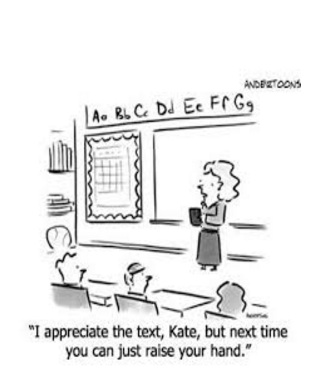
Finding that balance between tech and not using tech can be difficult. Some teachers feel it’s being over-used and never want to use it, and some teachers want to use it all the time. Where is that balance.
The Data
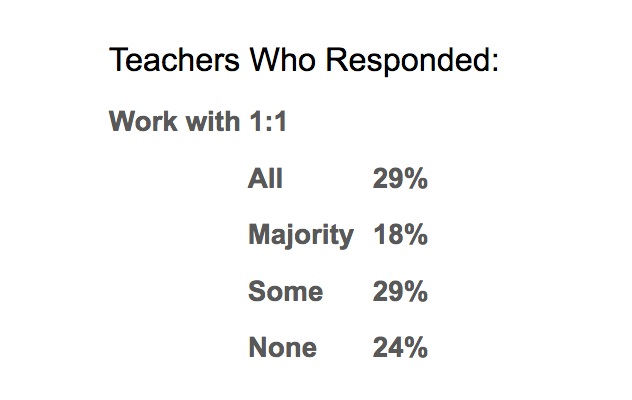
Of the teachers who responded, those who worked full time with the 1:1 program made up 29% of the respondents.
Teachers who indicated they work with 1:1 “a majority of the time”: we do have teachers who sometimes have to cross over and teach a high school course instead of just all middle school. They might have five 9th grade classes and one sophomore class. That was 18% of the respondents.
“Some” is a similar situation. And we did have teachers who responded who have no contact with the 1:1 program.
With the technology in the classroom we wanted to get a sense of how often teachers were using technology. So we asked “Before the PD, how often were you using technology?” That data is shown on the lefthand side. There was a < 40% response but no one went below 20%.
That number, 29% of teachers before this year used technology < 40% of the time — we do have some older teachers and some teachers who have been in the classroom for a long period of time and maybe are intimidated by it. Also some teachers teach a certain way and technology might not fit into it.
On the righthand side of the image above, you can see the results of the question “Now that we’ve had PD, how often do you use technology in the classroom?”
The > 90% stat dropped a little; we did have one teacher who reported going from >90% to that 70-79% area.
But we see very happily that the <40% number dropped a little.
When you’re looking at that data, this is how it aggregates:
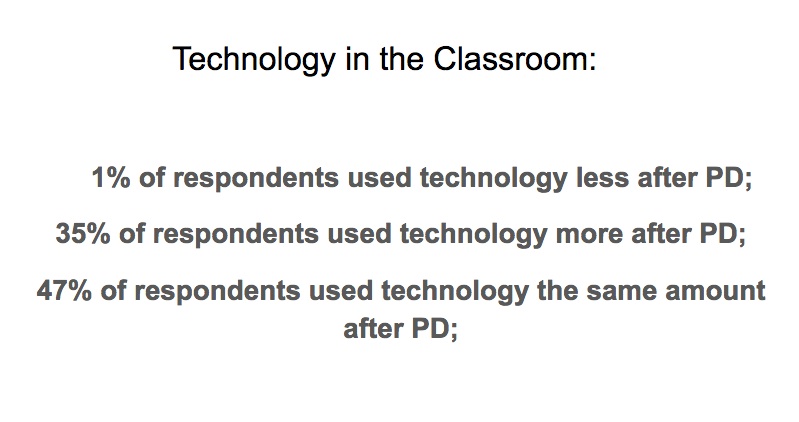
Of the 47% who stayed the same:
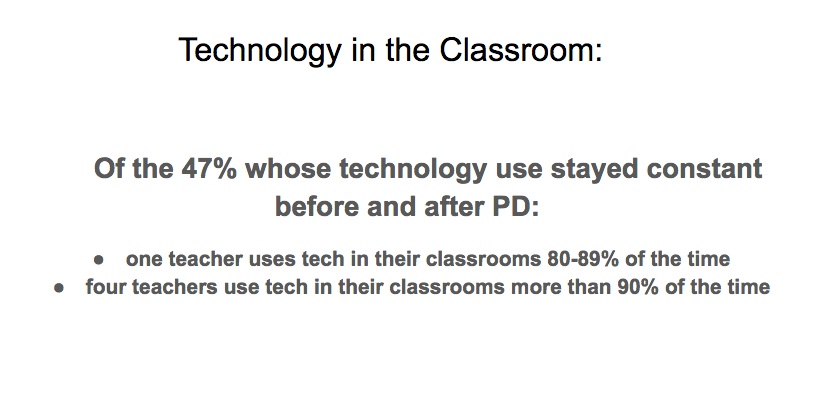
Those are great numbers.
One caveat:
The one thing that the survey can’t account for, however, is how the technology is being used. It’s one thing to have technology being used in your classroom 90% of the time, but are you just putting a presentation up and having them take notes the entire time? So effectiveness of technology in the classroom, we don’t have data on at this time.
As far as the other questions that were asked, Brendan Nerney’s going to be looking at the types of technology that were being used and how they were used.
Brendan Nerney: And I’m going to do it really quickly.
What types of technology are being used in the classroom and how are they being used?
What are they using in the classroom for lessons? You see a bit of a shift between the graphic on the left and the one on the right.
Nearpod use increased because we’ve begun using Common Sense Media’s curriculum on digital citizenship distributed through Nearpod. Google Slides and Google other things stayed pretty constant because we’re a Google school. We don’t have hats and tshirts or anything, but we use Google quite a bit.
Kahoot is now popular, as well as EdPuzzle. Definitely seeing a transition with the PD. It’s a kind of evolution: we’re trying new things and we’re letting older tools fall by the wayside.
We gave students at the end of the year last year a survey asking about their usage of the iPads, and we gave the survey again this year just recently.
What the students have been using the iPads for
They knew they could use it for things like checking their grades and emailing. The response options were:
- All the time
- Sometimes
- Once a week or so
- Never
They were checking the grade portal all the time when they first had access to it. They would drop a paper off on my desk and walk back to their desk and check to see if I’d entered it in the grade portal.
Not kidding.
Some of this we see a shift; I expected some different results here but I’m starting to understand. We’re now implementing technology more effectively. Not more often, necessarily, but in a more effective way, with greater diversity.
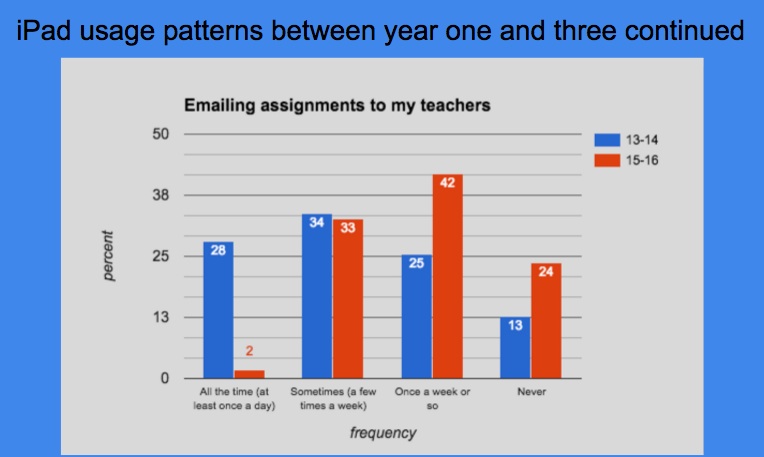
Emailing assignments to teachers: when students first got devices they were emailing all the time and now they’ve backed off a little bit on that.
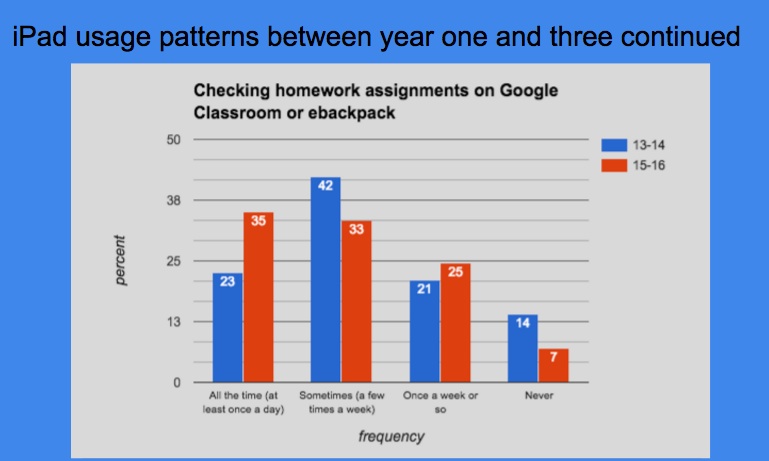
Checking homework assignments: we are actually committed more to using Google Classroom. So now what you’re seeing in the red, we as teachers are making sure we’re putting assignments up and resources up and telling students this is something you need to access. We’re communicating and collaborating on that platform.
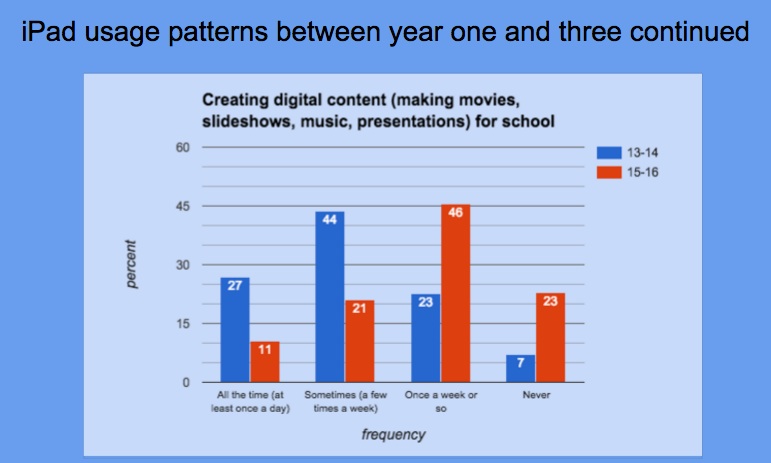
They created a lot of digital content at first: I’ve seen hundreds of Puppet Pals presentations with Abe Lincoln, describing everything I’ve ever asked students to explain.
We weren’t necessarily guiding that because we only had a couple weeks head start on the students with getting devices and I need a couple years head start.
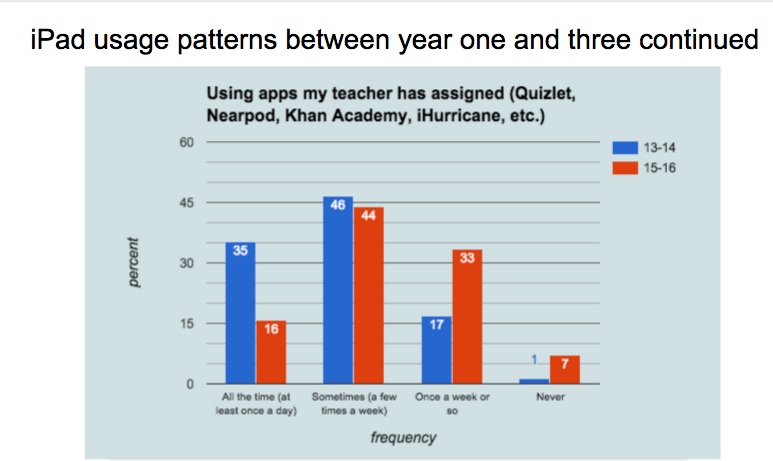
Using apps a teacher had assigned: again, at the beginning, we knew there were a bunch of apps on the iPads and it was like, “Here, do whatever you want to do with it.” We didn’t necessarily guide them through the best use of those apps for the instructional content we were trying to deliver. So we see a shift there.
What parts of having an iPad worked well?
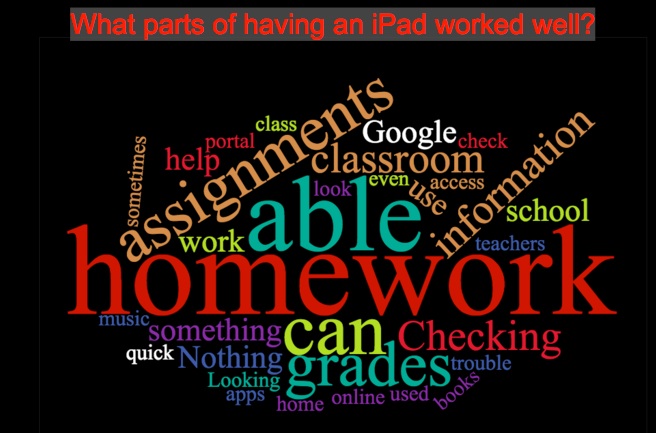
Really, access to teachers and homework, checking grades …very few students said “Nothing about it worked well, it’s a huge distraction”. Which it can be. Our tech ed specialist helped us by removing a lot of the distractions.
“What other ways did you use your iPad that didn’t list above?”
What were students doing outside of what we assigned? Healthy ways of using technology to de-stress: music, games, social aspects — pretty important.
Through MGI we were really lucky to have a concentrated period of time with people who had so much knowledge about different resources and different opportunities to get the most out of the technology.
An example unit: studying hurricanes
I was able to benefit when we were studying hurricanes, as we were able to decide as consumers to use an app called iHurricane. It gives you live feeds and updates, and you’re able to track hurricanes as they develop.
Kids were emailing me all the time. “Did you see what happened with Olaf?”
Yes, I did; please, stop emailing me these updates. 😀
But they were into it.
From there we went to use some other tools, like EdPuzzle, where they watched hurricane videos. I love EdPuzzle because you can see how many times a student watched particular segments — and if it was too technical or they didn’t understand it, they didn’t watch it. Then when they were asked an open-ended question about it you could tell the student who was watching the last two segments — which is where the more technical stuff was — they watched it seven or eight times. Just went back to it. And their open-ended response was right on target. Each individual student has their own strengths, and if you just keep persevering, going back until you really get it, that’s a really good sign.
As we looked at some of the hurricane stuff we’d post updates in Google Classroom, now we’re collaborating and communicating.
We utilized some Nearpod activities, to develop the skills in hurricane-tracking and determining hurricane speed. Students still used the old-fashioned maps and had to plot points, but we utilized the National Hurricane Center’s longitude/latitude distance calculators to help with some of that.
We were getting ready to tell a story and film a newscast, so we read a New York Times article on Hurricane Patricia, which we watched develop from its inception. Students were like, “What do you think is going to happen with it?” as they’re watching it form off the coast of Mexico. We actually watched that over a period of a week and a half. Once we read that article we put notes up for other people in Google Classroom.
And then finally they had to produce a newscast. Some of them used green-screen technology, and others used iMovie.
They had to do a newscast and do an update on the storm — they had a rubric and science was a big part of it. They had to talk about the evacuation and why it was successful. That was a creative component that finished the unit.
The opportunity to vary it and use the tools that were most appropriate at the level of the sequence became an important part of the development that MGI and the Tarrant Institute provided this summer.
Next steps
Mary Colvin: Next steps and questions: All our faculty members in grades 7, 8 and 9 were the folks who participated in the LoTi survey so we have a baseline of where we were, and that’s an important piece. And that lends itself to PLPs for teachers. Teachers setting goals for “How can I improve this?”
I feel like personally I’ve done this: yeah, in the past few years I’ve used a lot of technology, but I was really force-feeding it to my students. So I’ve set a goal of more beneficial, good use of tech in the classroom that makes sense and benefits both students and teachers.
This year we’re also preparing for student PLPs. That’s one of our roles this year as well. Previously we had a PLP coordinator who got the ball rolling with PLPs for students and the teachers will be taking that over. We had felt like the PLPs weren’t all that personal when we had an outside person in our building two days a week, trying to make this happen with the kids. The kids were like, “PLP, whatever that is. They’re taking me out of P.E. and my study hall that day and I don’t even know who this person is, I don’t know why I’m there…”
We felt this was another area of concern. We wanted to be with our kids, we wanted to be able to have those conversations with our kids. How are you learning this? Why are you learning this? What are those goals looking like? Not “I want an 80 in Math” but really good goals that have some teeth in them.
And then of course, a proficiency-based system. I’m just going to leave it at that. We’re in a year of unknowns and there are a lot of questions around that.
But all of us certainly are in agreement: we need to continue this. However that’s going to happen. If it means us trying to push it through, then that’s probably where we’re going to be.
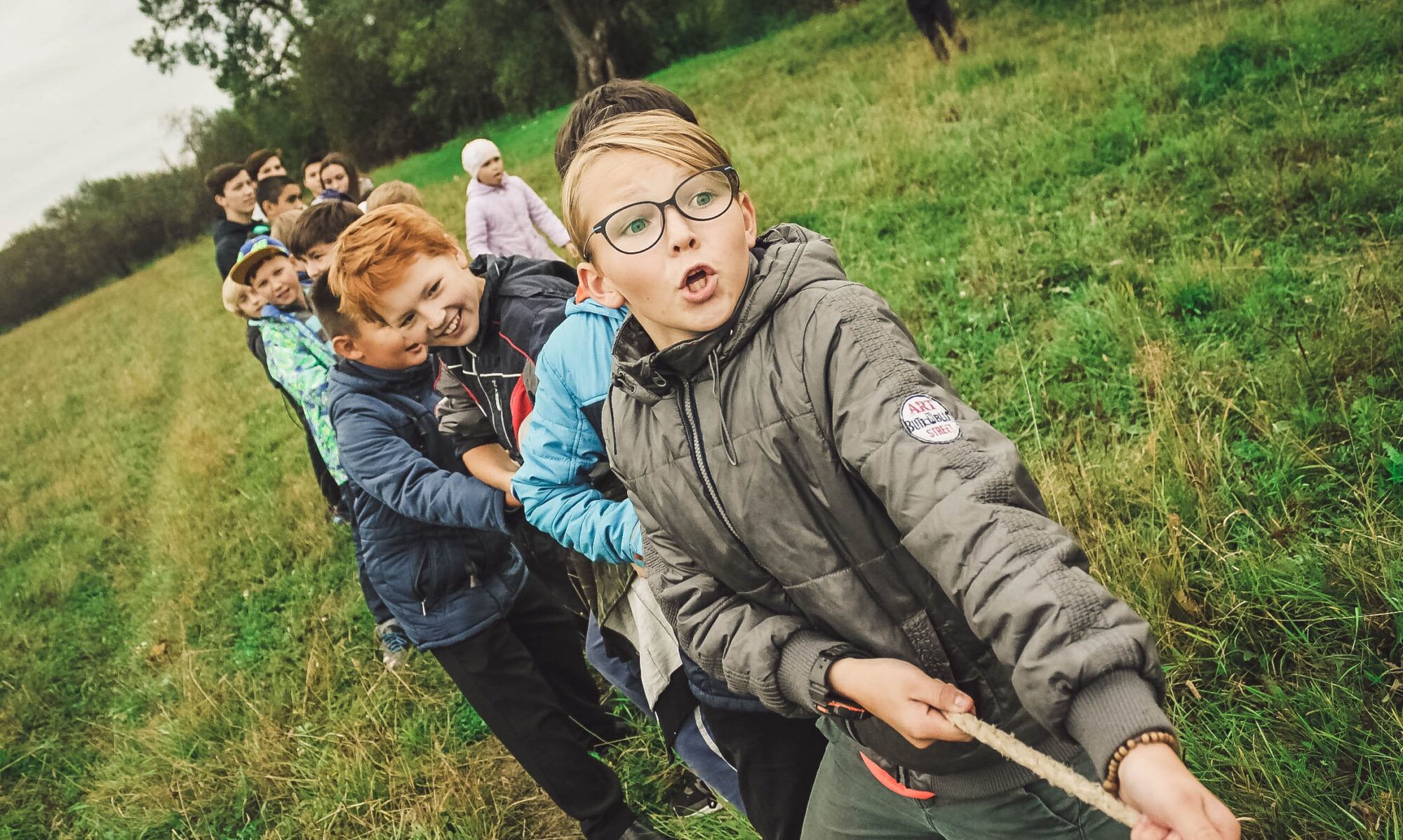

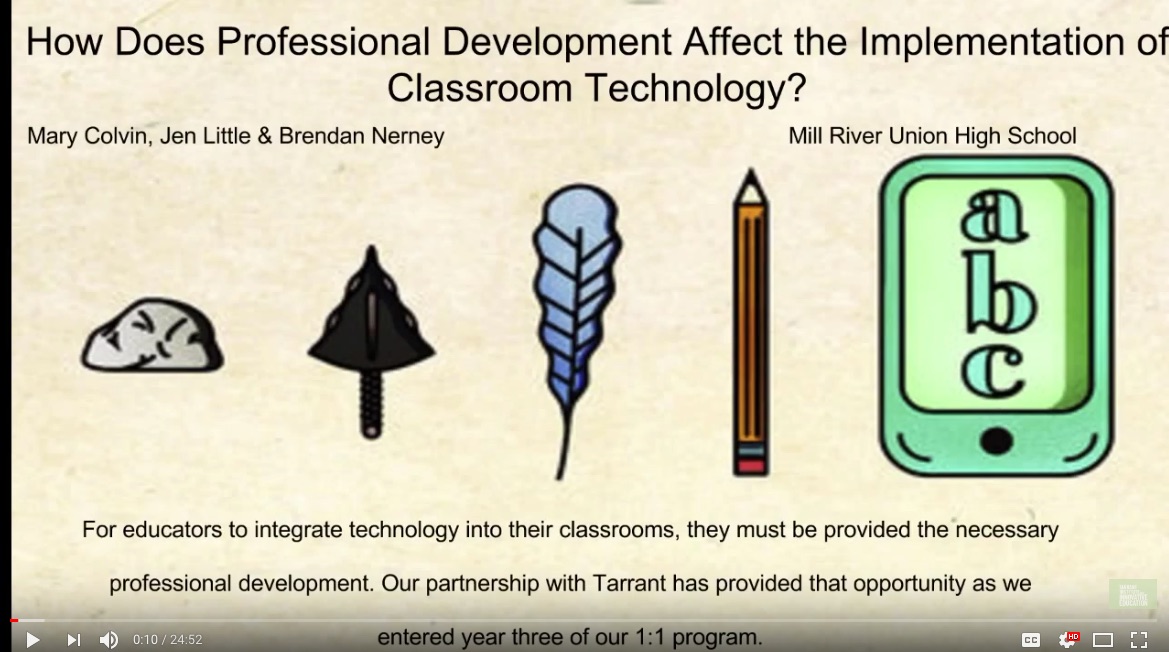
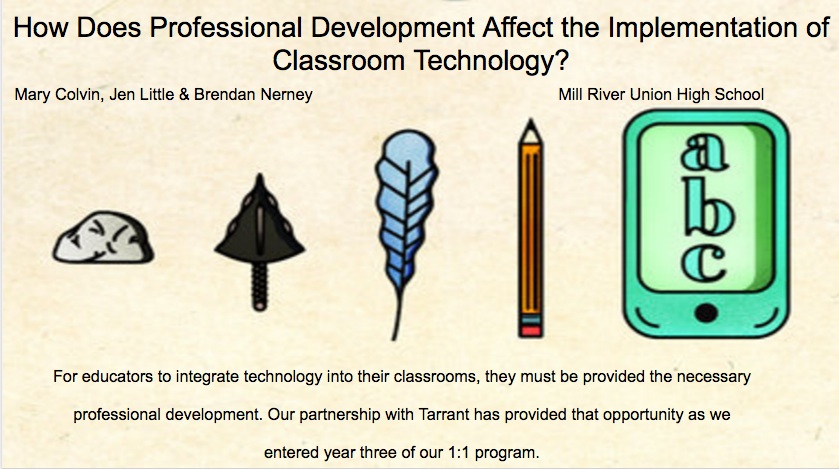
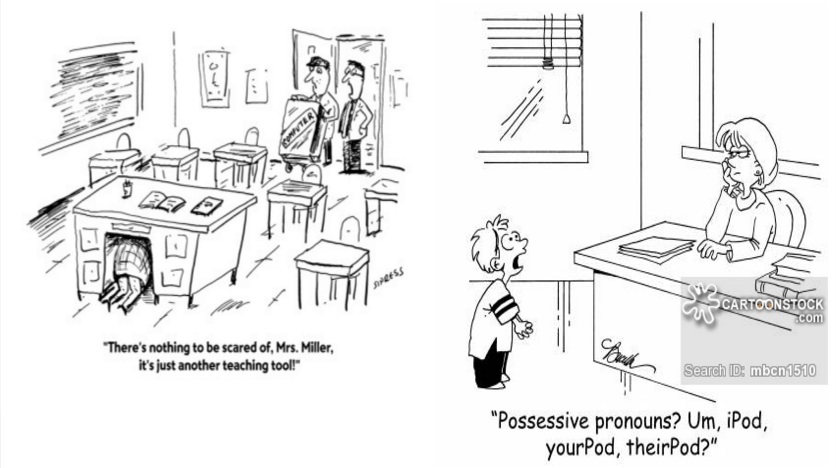
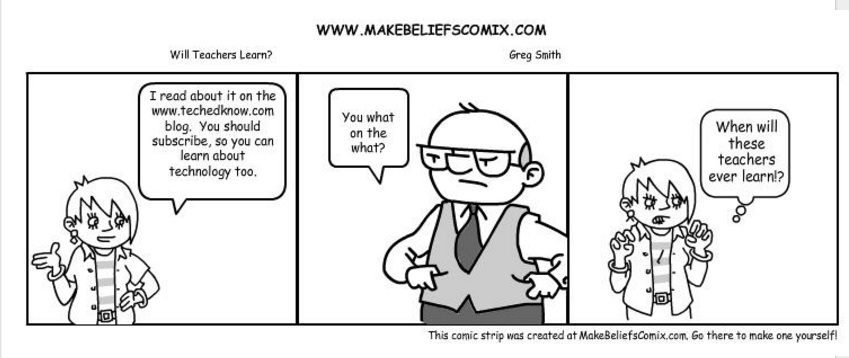

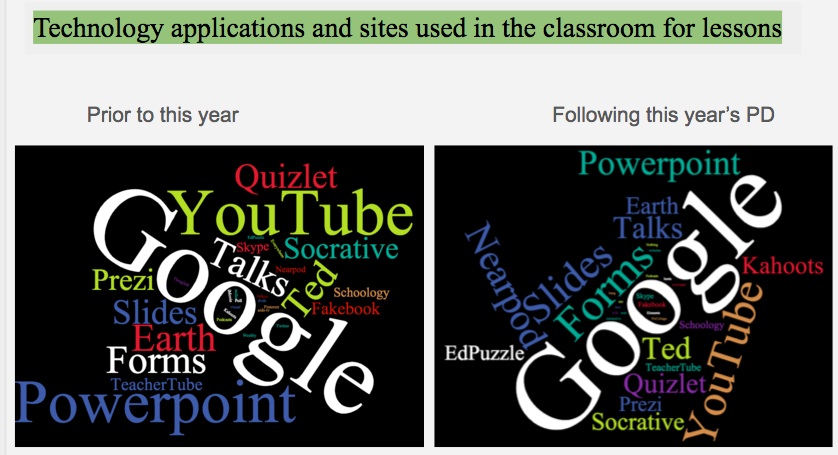
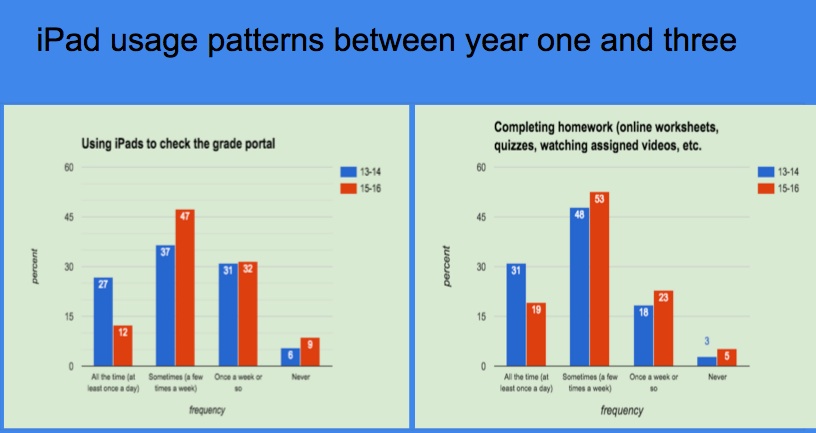
How does professional development affect technology integration? #vted https://t.co/hNQts9tsZD https://t.co/b3tz0wtiLh
RT @innovativeEd: How does professional development affect technology integration? #vted https://t.co/hNQts9tsZD https://t.co/b3tz0wtiLh
RT @innovativeEd: How does professional development affect technology integration? #vted https://t.co/hNQts9tsZD https://t.co/b3tz0wtiLh
RT @innovativeEd: How does professional development affect technology integration? #vted https://t.co/hNQts9tsZD https://t.co/b3tz0wtiLh
RT @innovativeEd: How does professional development affect technology integration? #vted https://t.co/hNQts9tsZD https://t.co/b3tz0wtiLh
How does professional development affect technology integration? A study by teachers, for teachers https://t.co/iDgACP6ieH
RT @innovativeEd: How does professional development affect technology integration? #vted https://t.co/hNQts9tsZD https://t.co/b3tz0wtiLh
How does professional development affect technology integration? https://t.co/3FUuErgjTy via @innovativeEd
How does professional development affect #tech integration? https://t.co/Pe2roT1go7 Via @innovativeEd #edtech Well: https://t.co/QbFZOCJtEw
thanks for post.
Technology is an advancing solution for a development of a business, whether small or medium size one, in today’s digital world opting a cloud software for your business is a right choice to excel, well nice article waiting for your next post. keep it up.